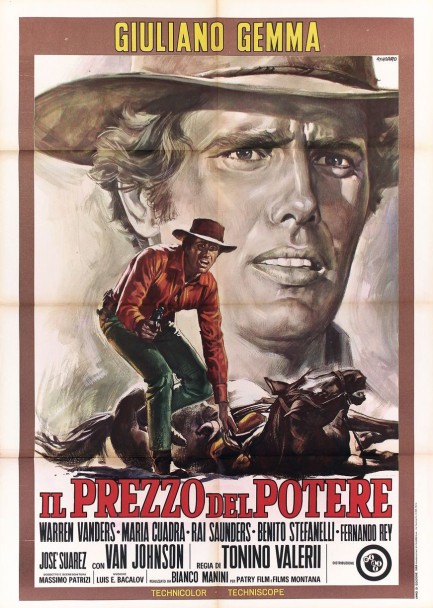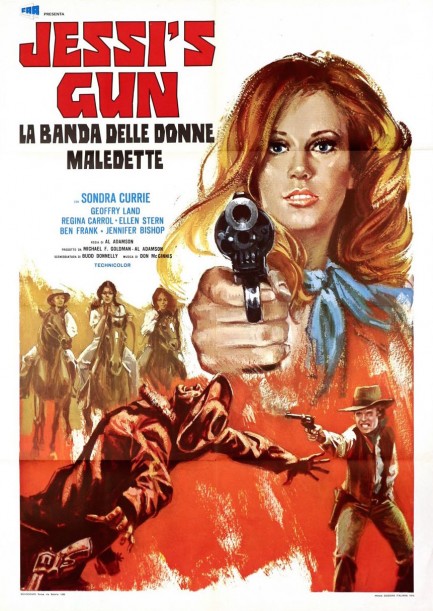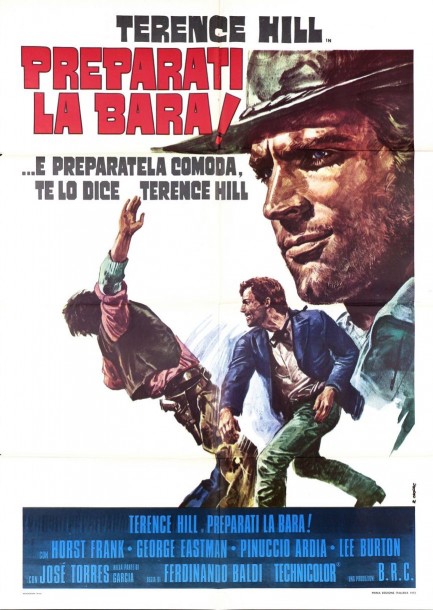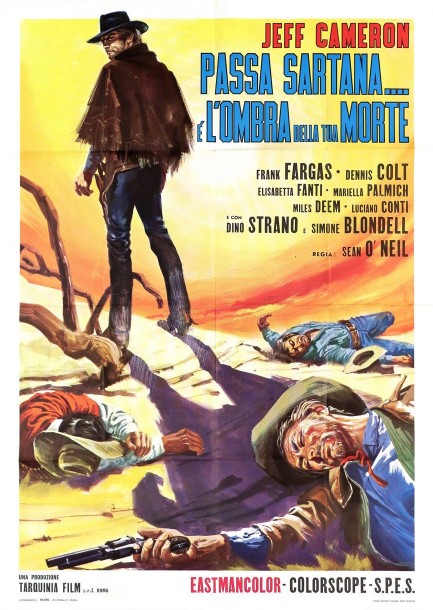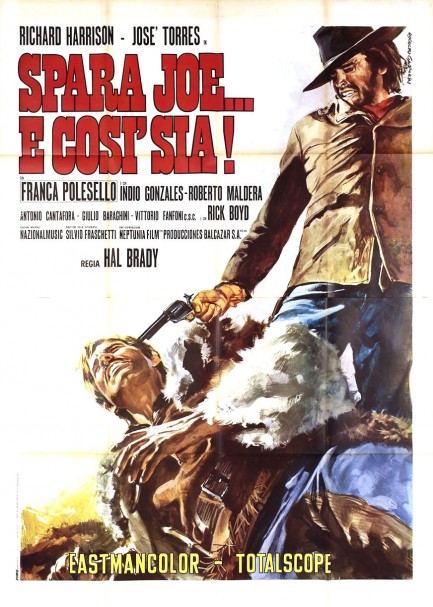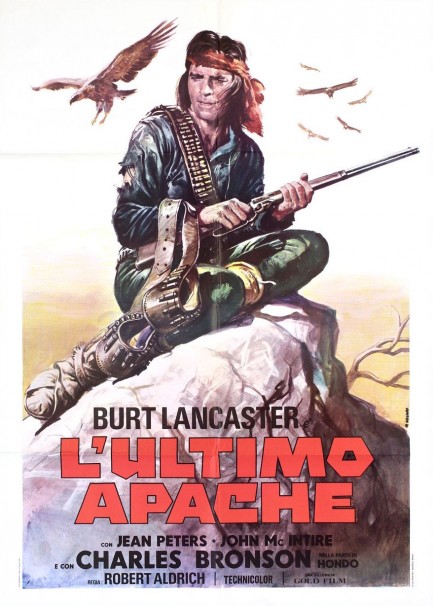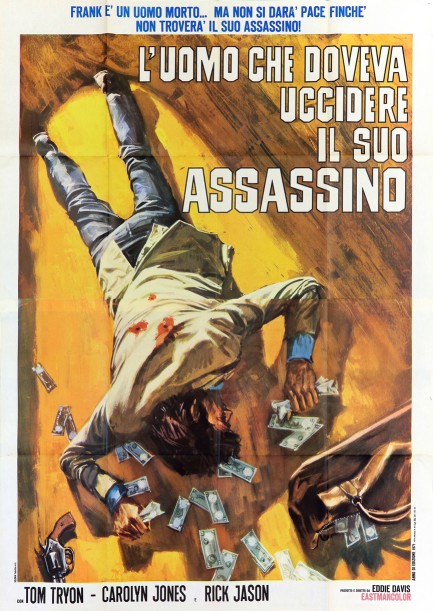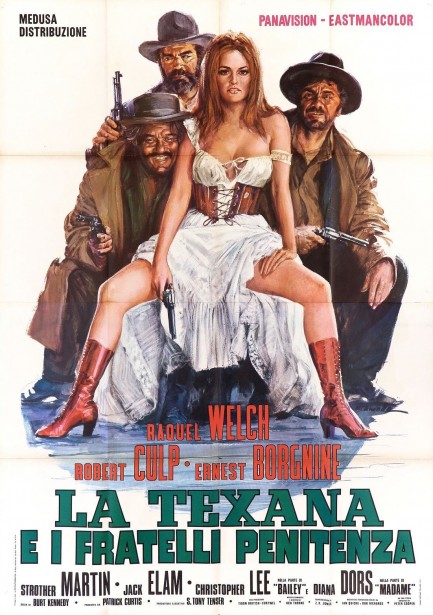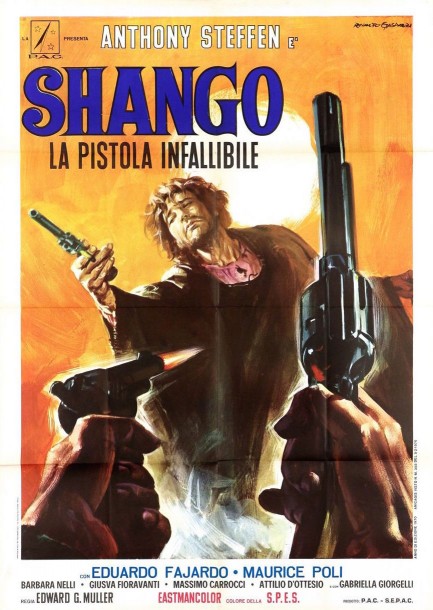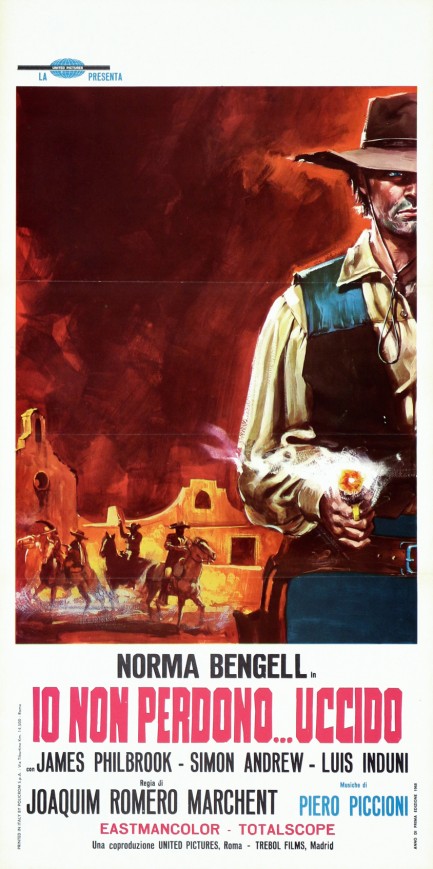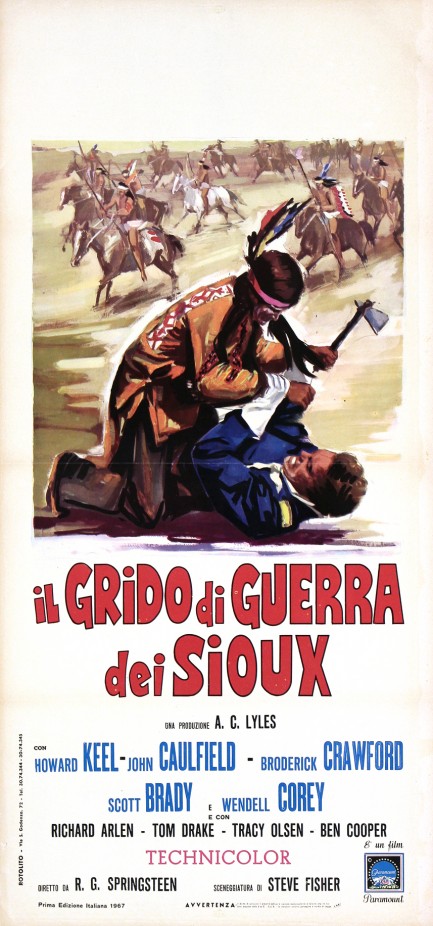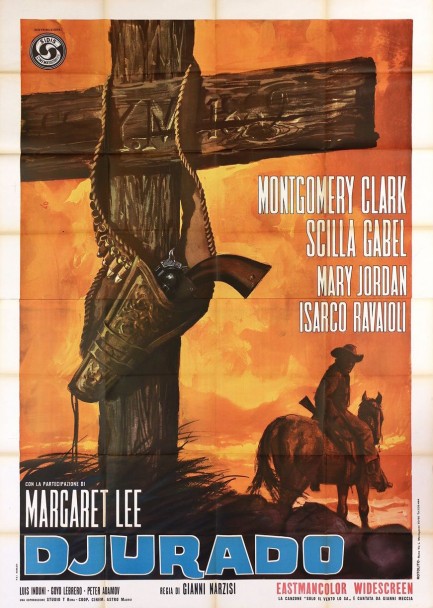 Did somebody order a spaghetti western with extra cheese? 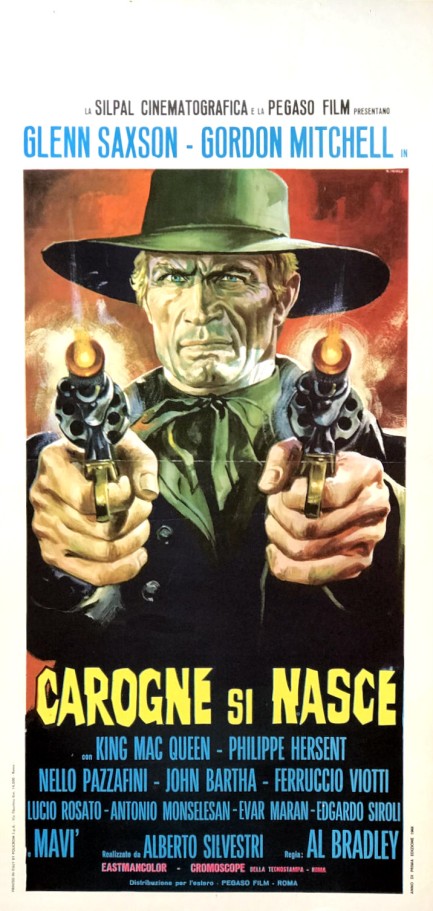
We take every opportunity we can to show you the work of Renato Casaro, even when it's used to promote a movie as bad as Carogne si nasce. Casaro painted a lot of spaghetti western posters but this one is a bit more intense than most. There's a reason for that—the character he painted was intense. The movie is known in English as Cry of Death, and it deals with conflict that erupts between squatters and ranchers in fictional Houstonville, Texas, and the marshal—Glenn Saxson—who first tries to stay out of it, but later chooses a side when he realizes that inside the land rights struggle is a deeper problem regarding someone's secret past and corruption amongst the town bigwigs. This is one cheap-ass movie. The budget is exemplified by a barroom brawl during which a character is shoved through a cardboard wall. Every castmember is a b-level actor at best. And the script—don't even bring up the script. It's like it was accidentally shot full of holes during one of the gunfights. But we'll give this cheeseball movie one thing—the main bad guy is amazing. He's played by ex-bodybuilder Gordon Mitchell, and he looks like a demon wearing bronzer. Spaghetti western producers were good at casting villains, and Mitchell fits the tradition with a capital V. Otherwise, this flick—even with its final act twist—is nowheresville. Carogne si nasce premiered in Italy today in 1968
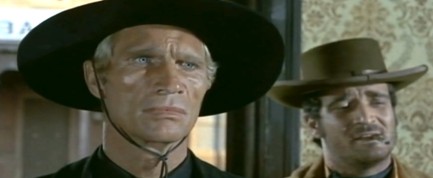 That's right. I'm the bad guy. You never guessed, did you? That's right. I'm the bad guy. You never guessed, did you?
 I'm pure evil, but I can smile winningly. See? I'm pure evil, but I can smile winningly. See?
 Though I'm from hell and consume only souls, I can mimic human rituals such as drinking beer. Though I'm from hell and consume only souls, I can mimic human rituals such as drinking beer.
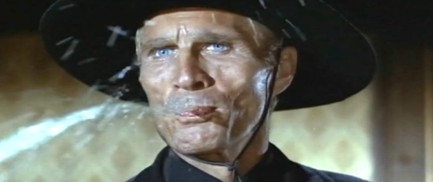 But I don't mimic swallowing it. My master should serve this pisswater to the thirsty wretches in his realm. But I don't mimic swallowing it. My master should serve this pisswater to the thirsty wretches in his realm.
 Dirty mind, clean body. 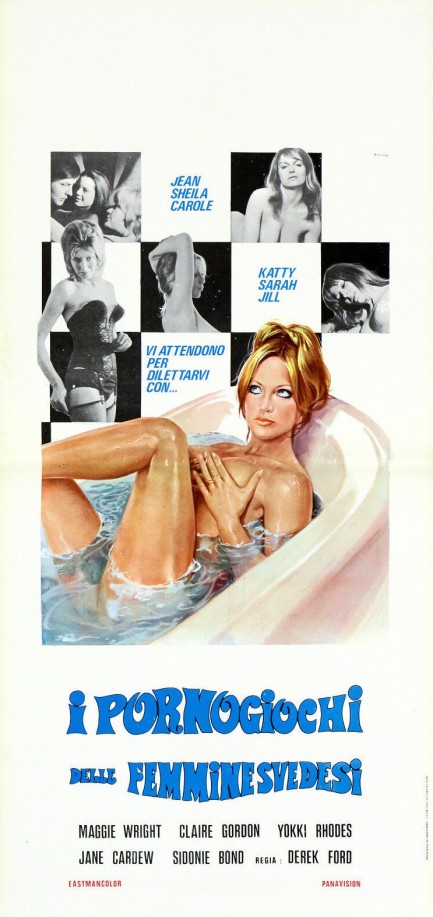 
Above: a poster for the 1972 sexploitation flick I pornogiochi delle femmine svedesi, painted by Italian illustrator Renato Casaro, along with a photo of star Claire Gordon going a rub-a-dub-dub with both hands in a tub, used by Casaro to inspire his creative process. The movie was originally made in England as Suburban Wives. While Gordon is lovely, and the poster is too, the movie is pretty dumb. Many years back we discussed it in a bit more detail and shared another Casaro promo, so if you're inclined to check that out, you can do so here.
 Welcome to the greatest show on Earth 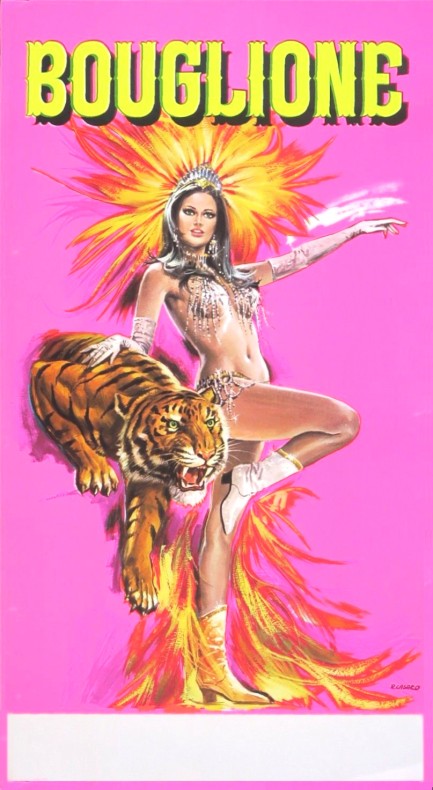
Renato Casaro was a celebrated Italian movie poster artist, but he worked in other media, including album sleeves and portraiture. Above he's created an advertising poster for Cirque d’Hiver Bouglione, a Parisian circus that traces its roots back to 1852, when Charles de Mornay, commonly referred to as Duc de Morny, undertook its creation and named it after his half brother Prince Louis-Napoléon III. When the circus finally opened in 1859 it featured equestrianism, animal acts, and aerial acrobatics from the famed Jules Léotard. After being interrupted by World War I, the business passed over to Gaston Desprez in 1923, and again in 1934 to the Bouglione Brothers, who were Italians who'd made a name for themselves traveling France with a menagerie and wild cat act. The circus was halted during World War II and the occuptation of its buildings by the Nazis, but emerged post-war to continue its growth and fame, known by then as Cirque d’Hiver Bouglione, the name it bears today. Casaro's lovely poster dates from 1970.
 A city with no exit. 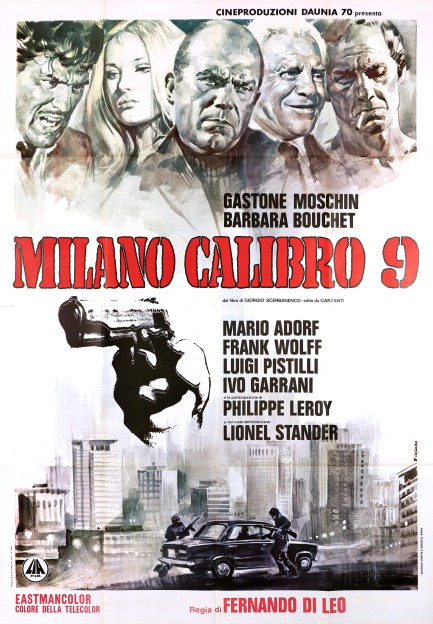
Milano Calibro 9, for which you see a promo poster painted by Renato Casaro, is a fun entry in the ranks of Italian crime cinema. Derived from a book of twenty-two short stories by Giorgio Scerbanenco, the plot follows a career thief played by a deadpan Gastone Moschin who's suspected by a crime kingpin of stealing $300,000 of his money. When Moschin is released from prison he's dogged by the kingpin and the local cops, who both want him to produce the cash. But he says he doesn't have it. The fact that the money is missing is what's keeping him alive for the moment, but if he doesn't come up with it the kingpin will kill him.
This trapped ex-con scenario runs along classic lines familiar to fans of vintage noirs, which works to the movie's benefit and disadvantage simultaneously. On the negative side, the plot offers little new in the gangster genre, and contemporary reviews pointed that out, but on the positive the movie has gritty Milan exteriors (shot when air pollution was still a major problem throughout the industrialized West), a cold-as-ice mood, a set of great character actors as various brutal criminals, and the presence of Barbara Bouchet as the world's least rhythmic but most beautiful go-go dancer.
What really sets Milano Calibro 9 apart, though, is its political undertones. The police investigation is hampered by a bitter division between classic rightwing commissioner Frank Wolff and far left head inspector Luigi Pistilli. Their ideological conflict and its implicaition of widespread class struggle in Italy gives the movie's fight over loose money a significance that still resonates today. In our era characterized by (among other serious problems) a yawning financial inequality gap, Milano Calibro 9 is a reminder that cinematic thrillers weren't always politically mindless. We recommend it. It premiered in Italy today in 1972.
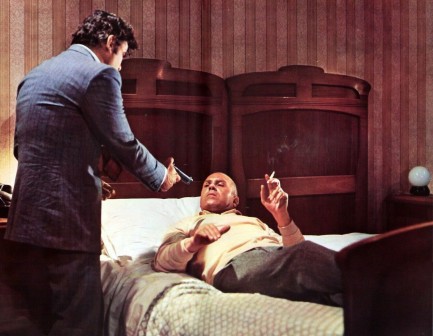  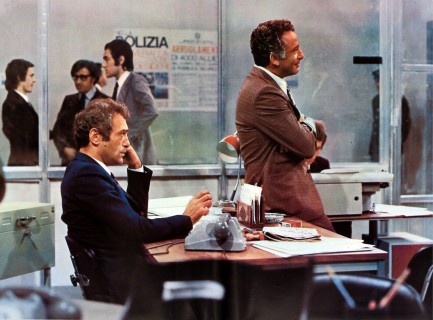 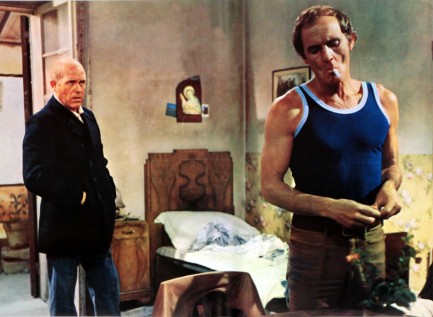 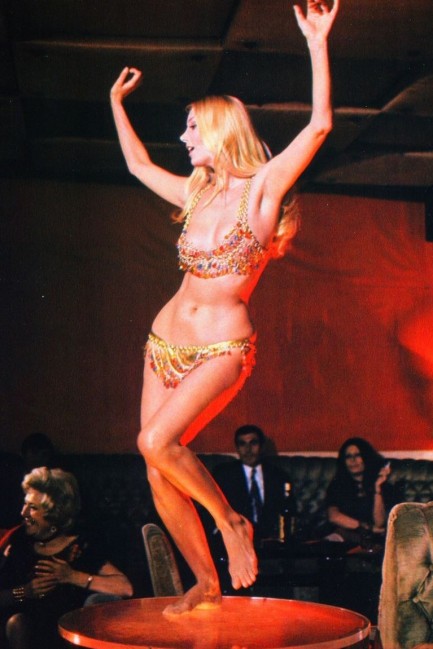 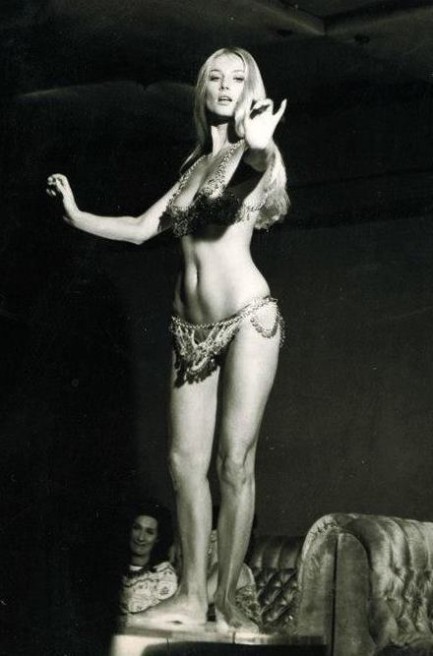  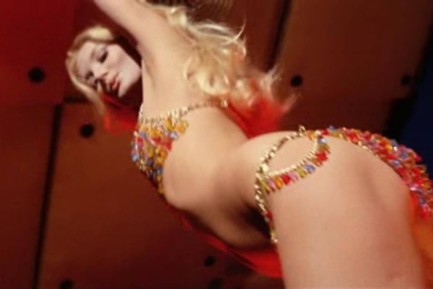   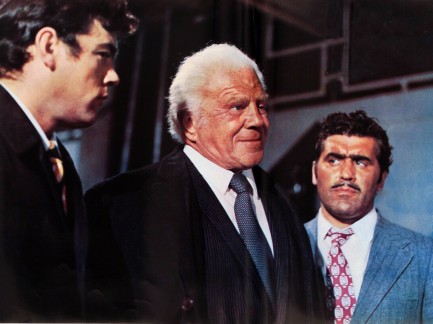 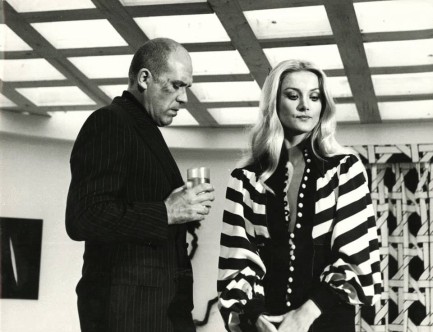  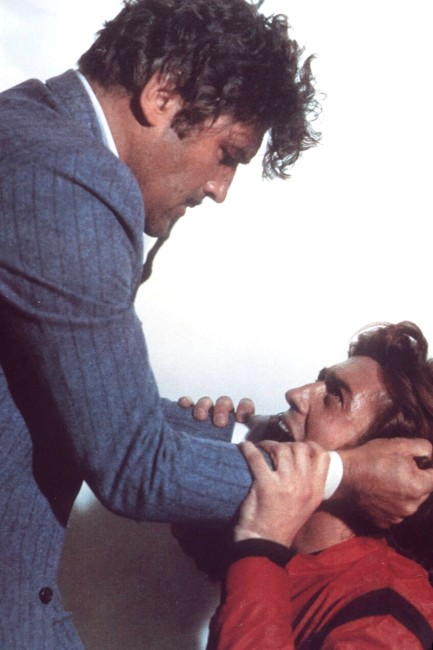 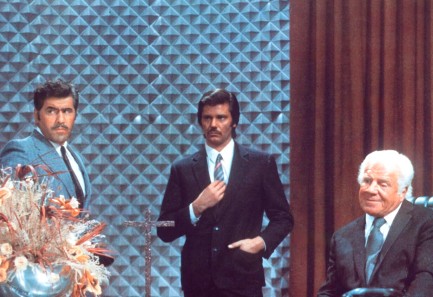 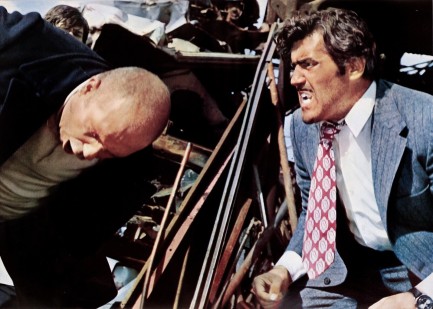 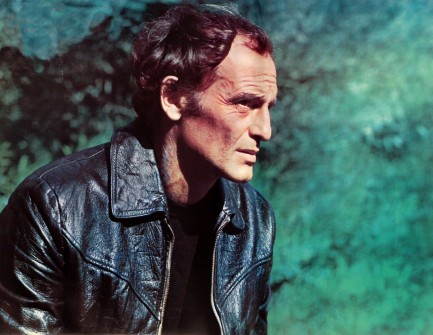 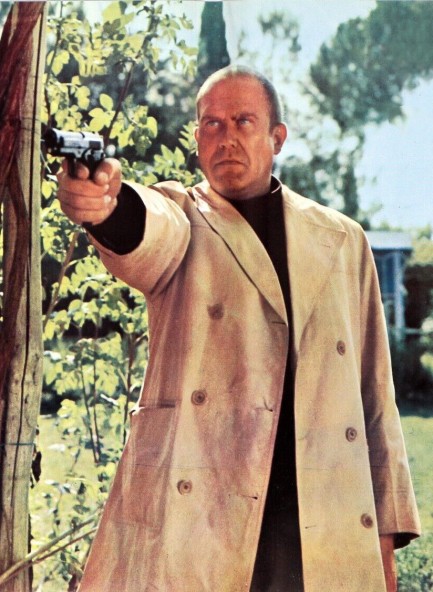
 Haiti gets hit by hurricane Anita. 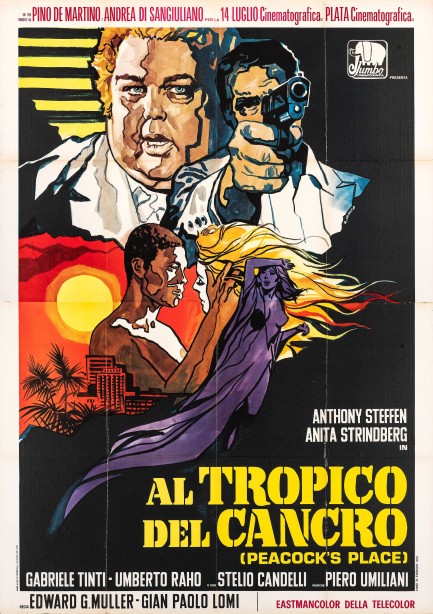 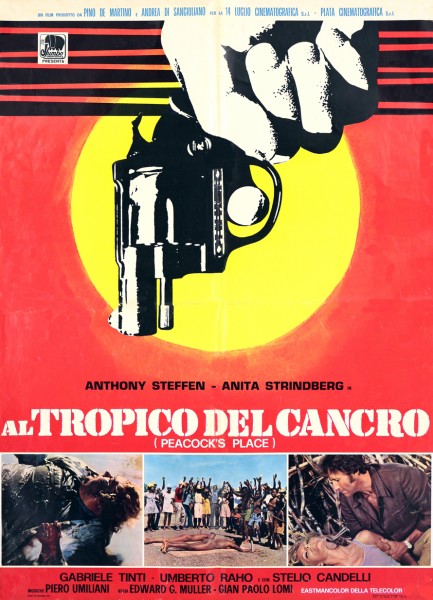
These two posters for Al tropico del cancro, aka Tropic of Cancer, were painted by Italian master Renato Casaro, and really demonstrate his artistic range, as they're stylistically different from the other poster he painted for the film. We have plenty of Casaro in the website, so if you want to see more just click his keywords below, or if you're pressed for time, you can see what we think is his best work here and here. He isn't the only person we want to highlight today. The movie stars Anita Strindberg, yet another luminous actress to come out of Sweden, and she plays a wife who travels to Haiti and is soon caught up in tropical sensuality, hallucinogenic drugs, and voodoo. It's unabashed exploitation ranging from the sexual to the cultural, and Strindberg is the main reason it's watchable, as you see below. Al tropico del cancro premiered in Italy today in 1972. 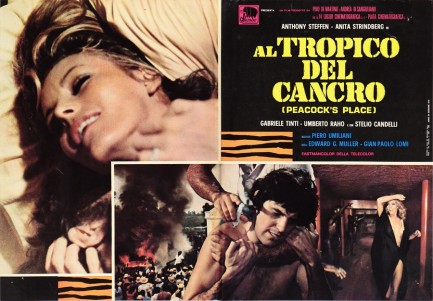 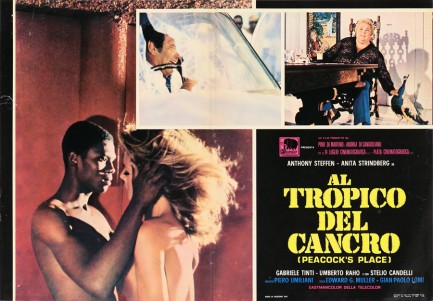 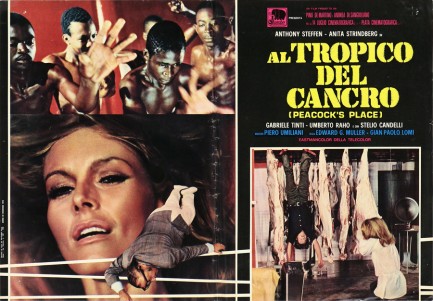 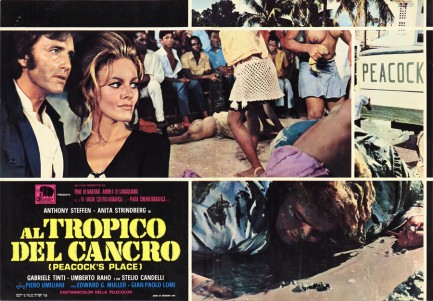 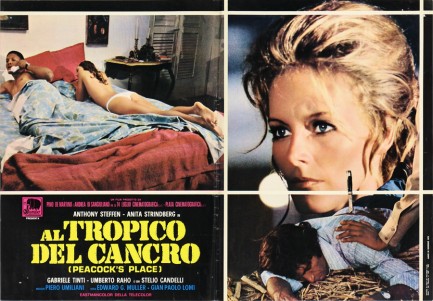 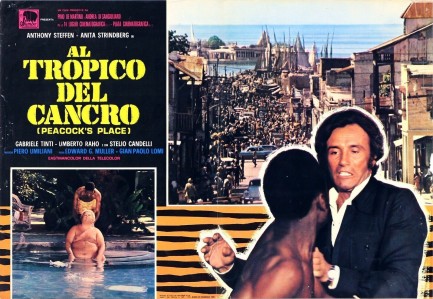 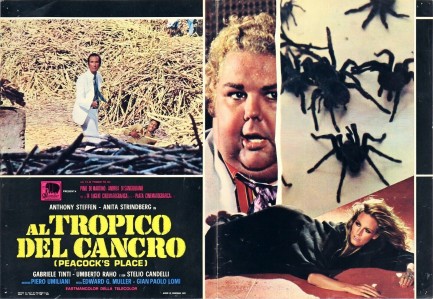 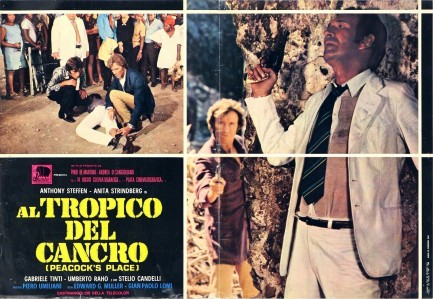 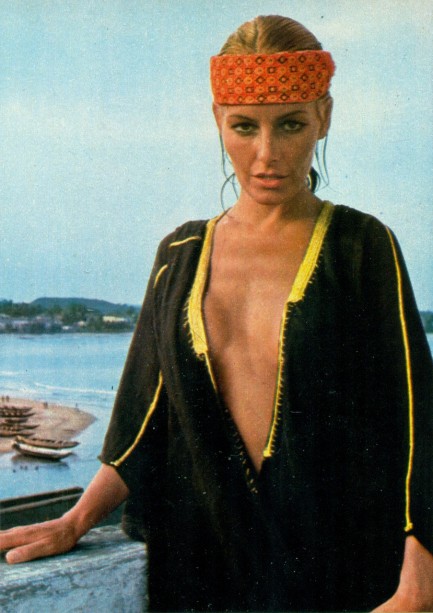 
 An American con man in London. 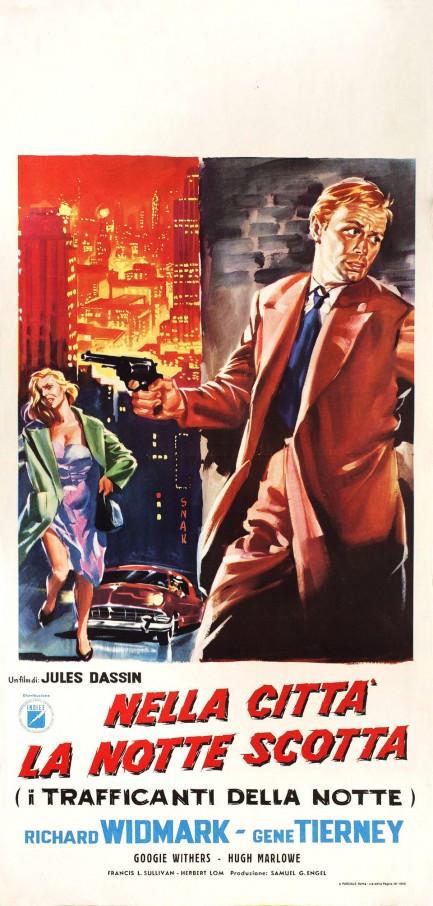
Above: a nice Italian poster for Jules Dassin's 1950 film noir Night and the City. The city is London, which proves to have numerous hazards for shady Richard Widmark. In Italy the movie was called I trafficanti della notte, then retitled Nella citta la notte scotta. You see both on the poster. Earlier promos exist that have only the first title, but we like this later one painted by Renato Casaro the most. It has a beautiful glowing cityscape in the background. Amazing work. We don't know why the title was changed, but the original translates as “the traffickers of the night," while the second is, “in the city the night is hot,” so maybe the distributors simply preferred the more poetic second title. We certainly do. We haven't talked about this movie yet, but we'll get to it a little later. It opened in Italy today in 1951.
 The fallout from this situation will be lethal. 
Above, an Italian poster painted by Renato Casaro for the Japanese macabre sci-fi flick Matango, which in Italy was called Matango il mostro and in the U.S. Attack of the Mushroom People. We shared the excellent Japanese posters back during the summer and you can see those here. The film opened in Italy at the Festival della Fantascienza di Trieste today in 1964.
 A film noir of a different color. 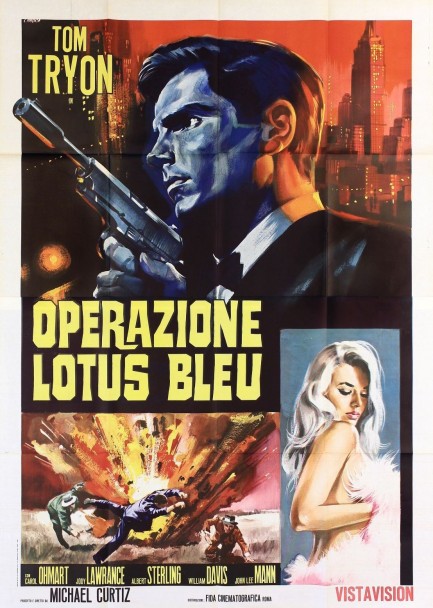 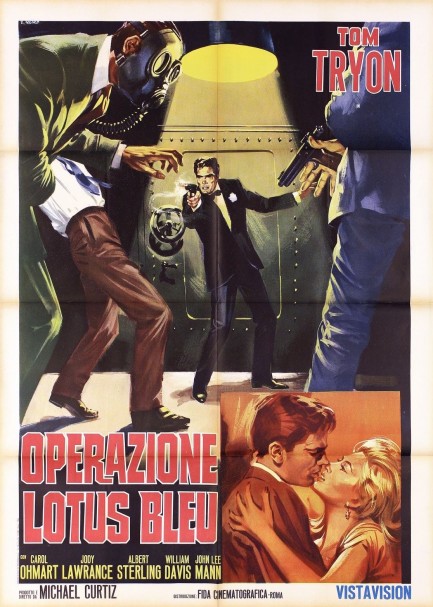
Above, two Italian posters for Operazione Lotus bleu, better known as The Scarlet Hour. Funny that the color in the title changed. Why not call it “operazione lotus rosso”? Actually, “bleu” isn't evan an Italian word, as far as we know, which makes this poster even weirder. Italian for blue is “blu.” The movie also played under a title translated literally from the English original—L'ora scarlatta—and we'd show you those posters but they don't compare to these. No surprise, since these were painted by the great Renato Casaro. As for the color change, that will likely remain a mystery. There's no known Italian release date for the film, but it premiered nearly everywhere in Europe between September and November of 1956. More here.
 Murder is in the eye of the beholder. 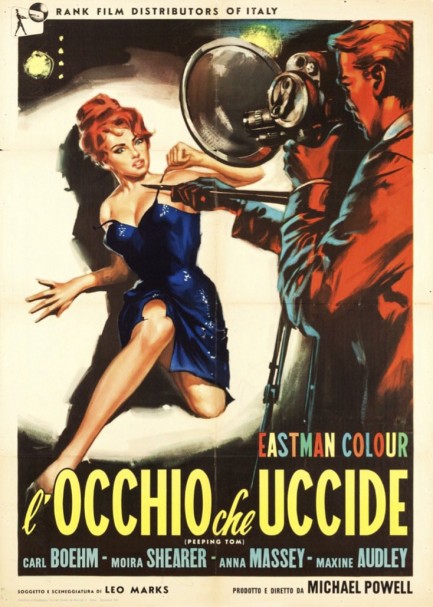 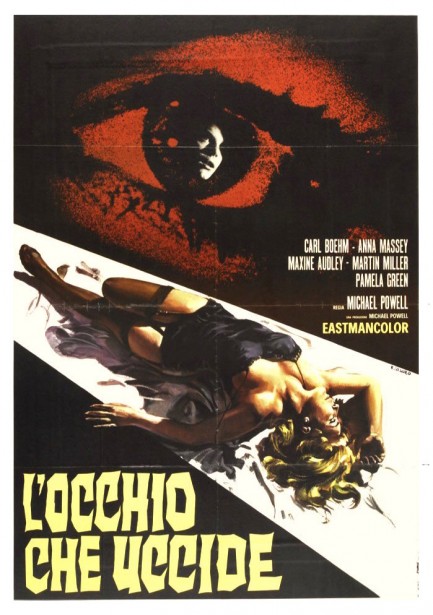 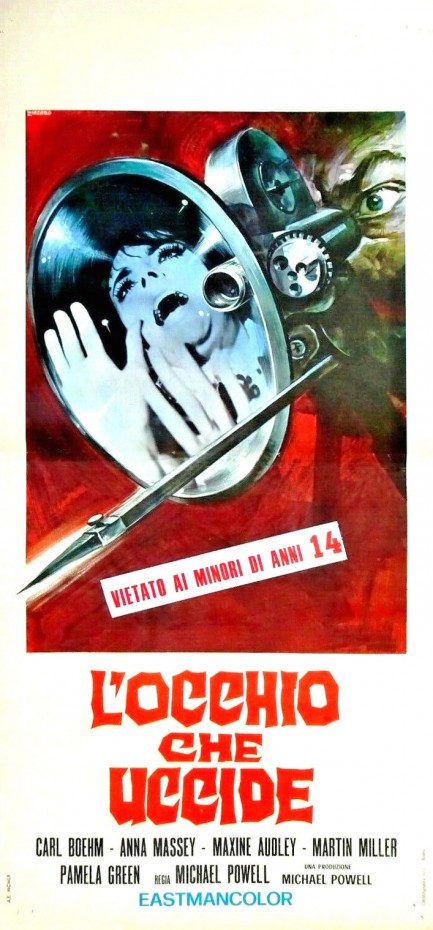
Above are three beautiful posters for L'occhio che uccide, or “the eye that kills,” which premiered in Italy today in 1961. The movie was originally called Peeping Tom when released in Britain in 1960. The second and third posters are signed by Renato Casaro, while the top one is unsigned. But it resembles his work, so what the heck—let's say he painted all three until someone corrects us. This movie was a career killer, a bizarre and confounding thriller that irreparably damaged the ambitions of director Michael Powell, but which today has ardent advocates. In the mood for a voyeur mass murderer who tries to turn his killings into art? See our write-up here, and check out a Japanese poster for the flick here.

|
 |

The headlines that mattered yesteryear.
1945—Mussolini Is Arrested
Italian dictator Benito Mussolini, his mistress Clara Petacci, and fifteen supporters are arrested by Italian partisans in Dongo, Italy while attempting to escape the region in the wake of the collapse of Mussolini's fascist government. The next day, Mussolini and his mistress are both executed, along with most of the members of their group. Their bodies are then trucked to Milan where they are hung upside down on meathooks from the roof of a gas station, then spat upon and stoned until they are unrecognizable. 1933—The Gestapo Is Formed
The Geheime Staatspolizei, aka Gestapo, the official secret police force of Nazi Germany, is established. It begins under the administration of SS leader Heinrich Himmler in his position as Chief of German Police, but by 1939 is administered by the Reichssicherheitshauptamt, or Reich Main Security Office, and is a feared entity in every corner of Germany and beyond. 1937—Guernica Is Bombed
In Spain during the Spanish Civil War, the Basque town of Guernica is bombed by the German Luftwaffe, resulting in widespread destruction and casualties. The Basque government reports 1,654 people killed, while later research suggests far fewer deaths, but regardless, Guernica is viewed as an example of terror bombing and other countries learn that Nazi Germany is committed to that tactic. The bombing also becomes inspiration for Pablo Picasso, resulting in a protest painting that is not only his most famous work, but one the most important pieces of art ever produced. 1939—Batman Debuts
In Detective Comics #27, DC Comics publishes its second major superhero, Batman, who becomes one of the most popular comic book characters of all time, and then a popular camp television series starring Adam West, and lastly a multi-million dollar movie franchise starring Michael Keaton, then George Clooney, and finally Christian Bale. 1953—Crick and Watson Publish DNA Results
British scientists James D Watson and Francis Crick publish an article detailing their discovery of the existence and structure of deoxyribonucleic acid, or DNA, in Nature magazine. Their findings answer one of the oldest and most fundamental questions of biology, that of how living things reproduce themselves.
|

|
|

It's easy. We have an uploader that makes it a snap. Use it to submit your art, text, header, and subhead. Your post can be funny, serious, or anything in between, as long as it's vintage pulp. You'll get a byline and experience the fleeting pride of free authorship. We'll edit your post for typos, but the rest is up to you. Click here to give us your best shot.

|
|


 That's right. I'm the bad guy. You never guessed, did you?
That's right. I'm the bad guy. You never guessed, did you? I'm pure evil, but I can smile winningly. See?
I'm pure evil, but I can smile winningly. See? Though I'm from hell and consume only souls, I can mimic human rituals such as drinking beer.
Though I'm from hell and consume only souls, I can mimic human rituals such as drinking beer. But I don't mimic swallowing it. My master should serve this pisswater to the thirsty wretches in his realm.
But I don't mimic swallowing it. My master should serve this pisswater to the thirsty wretches in his realm.


















































